Kayaking is arguably the best watersport. It opens up a whole new world of adventures for paddlers. You can kayak over the most dangerous waterfalls or enjoy a relaxed trip with your dog.
For all the various activities, there are specific types of kayaks. And getting the one that suits you is not always easy. So in this guide, we explore the differences, pros, and cons of 16 types of kayaks to help you with your decision.
Key Takeaways
- Kayaks can be divided into 16 types based on their design and purpose, each with its own unique features, pros, and cons.
- They can be categorized into sit-in and sit-on-top, hard-shell and inflatable, and single and tandem.
- They can also be specialized for activities such as recreational, touring, fishing, whitewater, surfing, diving, etc.
- Kayaks have various features that affect their performance, stability, maneuverability, storage, durability, and comfort.
- You should choose a kayak that best suits you according to your preferences and needs.
Types of Kayaks by Style
All kayaks fall under either one of two broad categories: sit-on-top and sit-in. When buying a kayak, the first decision you have to make is between a sit-in and a sit-on-top. Then you can move on to size and all those other factors.
1. Sit-In Kayaks

As the name suggests, this kayak type has a cockpit inside the hull where the paddler sits in. It’s only the lower body that goes into the cockpit. The deck is hollow to allow paddlers to stretch out their legs.
Pros of Sit-In Kayaks
Since you get inside a cockpit, you will be sitting at a lower level, hence a lower center of gravity and increased stability. This is especially true for secondary stability. (It is the ability of a kayak to remain stable when leaning on one side).
You are protected from the elements. With your lower body inside the cockpit, you will not be exposed to the harsh sun and you won’t get wet. Paddlers use a spray skirt to keep water out. This makes a sit-in kayak ideal for cold weather kayaking.
Sit-in kayaks have a low profile. This means less wind resistance and better performance.
Cons of Sit-In Kayaks
The biggest downside is that when one flips, the situation gets tricky. First of all, it is hard to reenter a capsized sit-in kayak. Beginners need training for this. The other thing is that if it fills with water, you have to take it back to shore to drain it. Fortunately, it’s not easy to flip a sit-in.
Sit-in kayaks are not the best for newbies because most of them have poor primary stability. Besides, if you are a total beginner, the idea of being inside the cockpit of such a small vessel is not very exciting. And when it capsizes, you have to be properly trained on what to do.
2. Sit-On-Top Kayaks
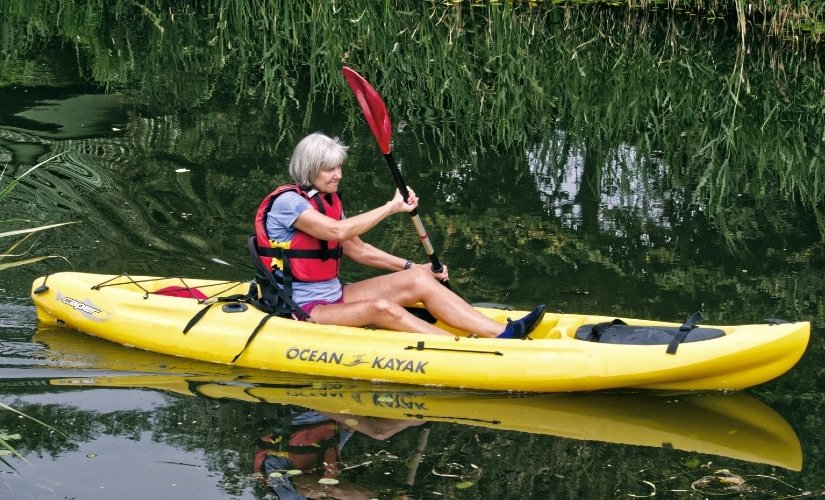
Unlike a sit-in-kayak, a sit on top kayak (SOT) doesn’t have a cockpit where you get in. Instead, paddlers sit on top of the deck—as you can guess from the name. There is a curved-in sitting area and a place for your legs with footwells.
Pros of Sit-On-Top Kayaks
SOTs are easy to get off of and get back on. You can jump off to get a quick swim and easily climb back on. This also makes it great for families. If you are kayaking with kids, they won’t feel trapped.
Sit-on-top kayaks are almost impossible to sink. They don’t have a cockpit that can fill with water. Most of them come with scupper holes that drain water, preventing it from collecting on the deck. Because of these features, you don’t need any advanced self-rescue skills in case the boat capsizes.
SOTs tend to be wider and much more stable than their sit-in counterparts. They are perfect for kayak fishing and casual kayaking with loved ones.
These types of kayaks are not complicated to build and are, therefore, more affordable than sit-ins.
Cons of Sit-On-Top Kayaks
It is hard not to get wet when kayaking with a SOT. First, you don’t have the protection of an enclosed cockpit. Second, the small holes that are so efficient in draining water also let some in. You should be prepared to get wet. This may not be an issue when it is warm, but when it is cold you’ll have a problem.
Sit-on-top kayaks are wide, which helps with stability. It is the reason why they are preferred for fishing and beginners. However, this width increases resistance, making them slow.
Types of Kayaks by Construction
This is another broad category. Kayaks can either be hard-shell, inflatable, or folding. The debate is usually between inflatables and hard-shells. But the folding kayak option is also quite nice.
3. Hard-Shell Kayaks

These are probably the most common. They are made from a wide range of materials including fiberglass, wood, plastic, and composite materials.
Pros of Hard-Shell Kayaks
Solid boats offer great performance. They are rigid and this allows them to glide smoothly and efficiently on water. They also have better speed compared to inflatable kayaks.
Hard-shell kayaks are easy to control. When kayaking in extreme conditions, you want a yak that you can maneuver without issues. A solid boat stays in line and will not be tossed in every direction.
You don’t need any complicated setup processes. Rigid kayaks are ready to go. All you have to do is get it to the water. At the end of your expedition, get it back home and into storage—no inflation or deflation.
Cons of Hard-Shell Kayaks
These kayaks are expensive. The materials used to make them aren’t cheap and you, as the consumer, have to bear some of that cost. You can still find cheap rigid boats but the quality is nothing to write home about.
They require large storage space. Can you imagine having a 14-foot long yak in your small apartment? If you buy a rigid kayak, you’ll have to make room for it.
Transporting them is stressful. Hard-shell kayaks are heavy. One person can barely carry it alone. A friend may have help every time you want to load it onto a vehicle or get it to the water.
The materials are not comfortable. Initially, you may not notice this. But after spending hours on the water, you will want to rest on a soft platform. Almost every part of a solid kayak is hard.
4. Inflatable Kayaks
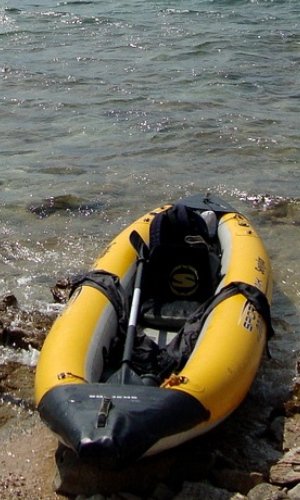
Inflatable kayaks are boats that you blow up before use and deflate once you are done. They are becoming more popular by the day because of their attractive benefits.
Pros of Inflatable Kayaks
They are cheaper. The materials used to make inflatable kayaks are not expensive. You can get a good one at an affordable price. They are suitable for beginners and people on a budget.
Blow up boats are more durable. Most of them are built using Dropstitch and PVC construction. It makes them long-lasting and hard to dent. When they hit rocks, most inflatable kayaks will bounce off instead of getting dinged.
You can store your inflatable kayak under the bed. That’s right. Once deflated, throw them in the bag they came in and store them anywhere. This is convenient for people who have small apartments and spaces.
They are portable. Most blow up yaks are lightweight and can be carried by one person. And you won’t have to struggle loading them onto the car roof. Transport them deflated and inflate them when you get to your destination. You can travel with your inflatable kayak to anywhere in the world.
Cons of Inflatable Kayaks
Inflation and deflation can be a chore. It is not fun having to spend time and effort blowing up your boat almost every time you want to kayak. It would be nice to get it from the car and straight into the water.
Lower your expectations when it comes to performance. All these benefits have a cost. Inflatable kayaks may be decently rigid but they are not exactly as rigid as solid kayaks. They will not be as fast. And they are light too so when conditions are extreme, controlling them will be tough.
5. Folding Kayaks
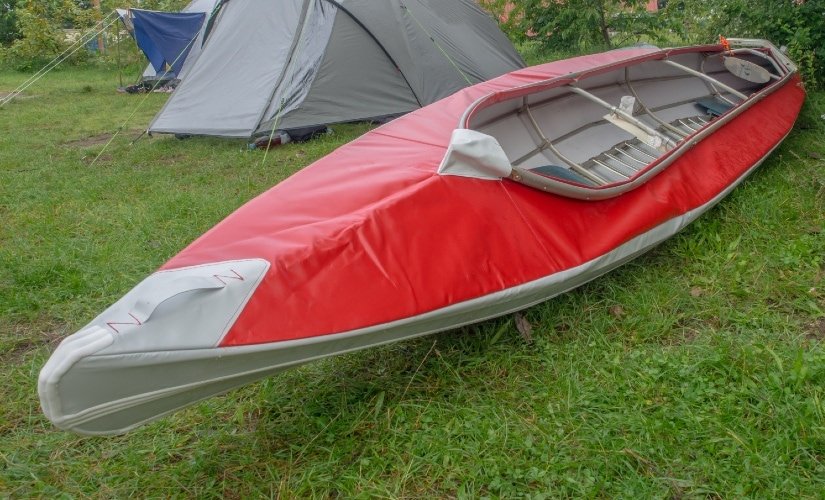
Way back in the day, some people used to make kayaks with stretched animal skin. To give it the kayak shape, the skin would be supported using bone or wood frames. This design still exists today. The frames are now made of plastic, wood, and aluminum. Instead of skin, strong, waterproof materials are used.
Pros of Folding Kayaks
They offer the best of both worlds. A folding kayak has the benefits of the hard-shell and the inflatable without most of the drawbacks.
Folding kayaks are portable. Once folded and put in a bag, there’s nowhere you can’t go with your boat. They are also very lightweight and can be carried by one person.
The setup process is simple and quick. With an inflatable, you have to blow it up first. With a rigid kayak, you’ll struggle to get it into the water. A folding kayak eliminates both of these inconveniences. Get it out of the bag, unfold it, and go have fun.
Folding kayaks are more rigid than inflatable ones. This means that their performance is impressive. Most people don’t expect a folding boat to be great. But they glide quite well.
Cons of Folding Kayaks
They are expensive. For all these benefits you may have to cough up a lot of money. But this is expected. The design is amazing and combines the benefits of the inflatable and the hard-shell while eliminating most of the cons.
The material can be dented. This is the one place that an inflatable is better than a folding kayak. You can take your blow up kayak anywhere and it won’t have a single scratch at the end of the day. With a folding kayak, you have to be careful especially if the area is rocky.
Types of Kayaks by Use
As already mentioned, kayaks are used for all sorts of water-related activities. Here, we look at the different types based on their purposes.
6. Recreational Kayaks
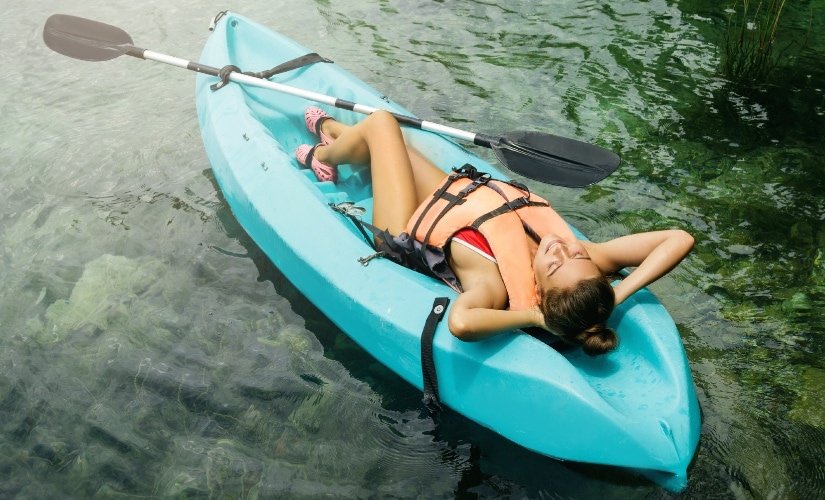
These are kayaks meant for relaxed paddling on calm waters. They are mainly medium-sized, 10 to 12 feet long, and 28 to about 32 inches wide. The kayaks are stable and beginner-friendly.
Pros of Recreational Kayaks
They are easy to get in and out of. Recreational kayaks typically have a spacious cockpit where you can quickly hop on and off.
The kayaks are suitable for newbies. The extra width makes them stable and the ease of entry is something that many beginners will appreciate. The length is also not too much and this makes the yaks maneuverable.
They are less expensive. Recreational boats don’t come with fancy features and they are not made using expensive materials. They are affordable for most people. It’s another thing that makes them fantastic entry-level vessels.
Cons of Recreational Kayaks
The kayaks come with limited space. They are designed for a few hours of kayaking and, therefore, don’t have as much storage space. If you want something that can hold a lot of luggage, this may not be it.
The speed can be disappointing. Wider kayaks are more stable. But this is at the expense of speed. Wide boats, unlike narrower ones, have more resistance while moving on the water. Don’t expect your recreational kayak to glide like a touring kayak.
These kayaks are also shorter. This, and the wide hull, negatively affect their ability to track (move in a straight line).
7. Touring Kayaks
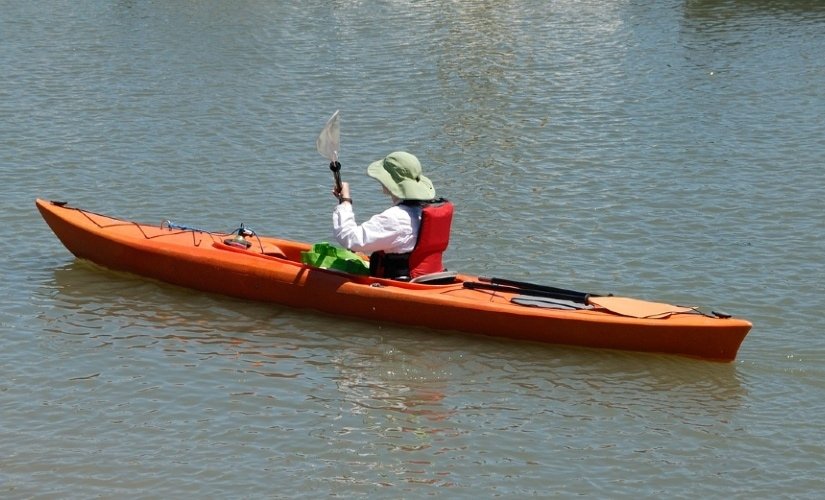
Also known as sea kayaks, touring kayaks are boats built for long excursions on open water. They are narrower than recreational kayaks and much longer (about 14 to 20 feet).
Pros of Touring Kayaks
The speed is outstanding. Sea kayaks are long and narrow. They have a streamlined shape that enables them to cut through the water with less resistance compared to recreational kayaks. They are suited for kayakers who love to cover longer distances in a short time.
There is ample storage. Touring kayaks can be really long. This length comes with the added advantage of storage space. They have lots of compartments for paddlers to bring everything they need during their trips. Some of the storage areas are waterproof to keep your belongings dry.
Lastly, sea boats track remarkably. The same features that enhance speed also enhance tracking capabilities. A touring kayak maintains a course way better than a recreational kayak.
Cons of Touring Kayaks
The length of a kayak determines how maneuverable it is. Shorter ones are easier to handle. Touring kayaks can be extremely long. And while this improves speed and tracking, it makes handling hard, especially when you have to make quick turns. For this reason, these types of kayaks are best for intermediate and advanced kayakers.
You will pay more. Touring kayaks are constructed using more expensive materials and advanced technology. This comes at a higher cost.
Sea boats are a pain to transport. Think about how complicated it is to travel with a 20-foot kayak. It may be simpler if you live close to the water. But over long distances, it will not be a very fun experience.
Note: There is another sub-type of touring kayaks, day-touring kayaks. They are slightly shorter and have less storage space compared to touring kayaks. They are good for shorter trips.
8. Fishing Kayaks
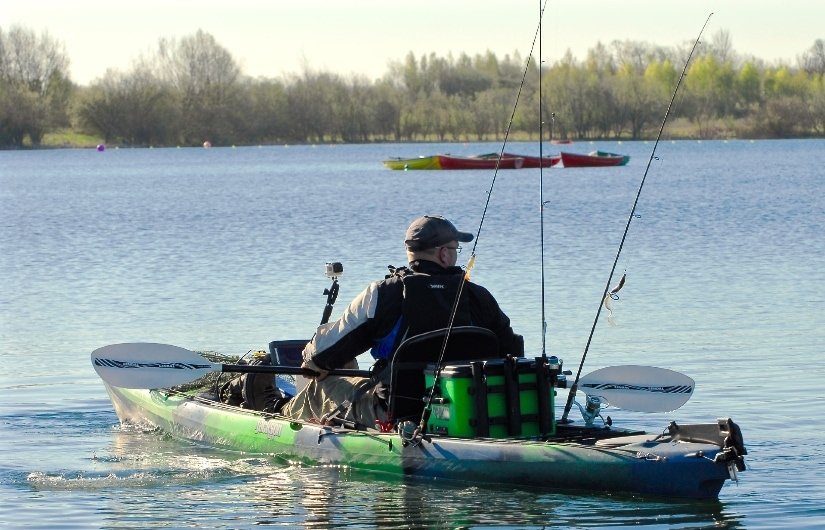
Fishing kayaks are quite similar to recreational kayaks. They are wider, sometimes shorter, and mainly SOTs. The boats are designed to hold a lot of gear and have features convenient for anglers.
Pros of Fishing Kayaks
Since these kayaks are wide (some wider than 35 inches), the stability is impeccable. With most of them, more so the sit-on-tops, anglers can comfortably fish while standing.
They are maneuverable. The length of a kayak determines how maneuverable it will be. Fishing kayaks are short. Anyone, regardless of size, will find them easy to control. They turn amazingly too.
Angling kayaks have a high weight capacity. You will need a place to put all your gear and your catch. And you’ll want to bring refreshments as well because it can take a while. For them to hold all these things, most fishing kayaks have a higher weight capacity than a regular kayak.
The kayaks are customized for fishing. They come with fishing rod holders, storage hatches, bottle holders, paddle holders, and tons of other features.
Cons of Fishing Kayaks
Angling kayaks are slow. Short and wide is not exactly the best design for speed. They have more resistance and don’t slice through the water like sea kayaks. Paddling is not as efficient and you may get tired when covering long distances. Luckily, you can install a trolling motor.
9. Whitewater Kayaks
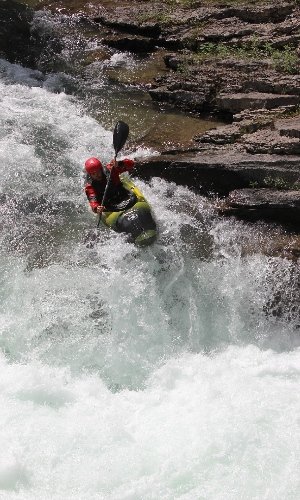
Whitewater kayaks are built for kayaking in extremely rough water situations. It is a great activity for people who want to feel the rush. These kayaks are very short and narrow. There are several types of whitewater kayaks. They include long-boats, creekers, playboats, and river runners.
Pros of Whitewater Kayaks
These boats are quite maneuverable. In those rough conditions, it is important for the paddler to always be in control of the boat. That is why whitewater kayaks are short and narrow. They are easy to control and responsive.
Because of the situations they are designed for, you don’t have to worry about getting wet. With a spray skirt, you will remain dry.
The kayaks are durable. Just search for whitewater kayaking videos on YouTube and see. There are rapids, scary waterfalls, rocks, and sometimes, vegetation. For a kayak to survive that, it has to be made using state-of-the-art construction.
Cons of Whitewater Kayaks
They are only good for the situations they are built for. On a calm lake, a whitewater kayak would be unstable and not very fun. So while most of the other kayak types may work in different scenarios, a whitewater yak won’t.
10. Crossover Kayaks
Crossover kayaks are designed for multiple kayaking variations. They are like a combination of different kayak types: touring, whitewater, recreational, etc.
Pros of Crossover Kayaks
The obvious one is that you don’t have to choose a specific kayaking activity. Some paddlers would love to enjoy touring, recreational paddling, and surfing. So why not get a boat that lets you do all of that?
You save money. Imagine how much it would cost you to buy a specific kayak for every activity you like. Some of them are crazy expensive. You would have to dig very deep into your pockets. This is one of the reasons why more kayakers are preferring crossover kayaks.
Even if you could afford all those kayaks, where would you put them? Not everyone has that much space. With a crossover, you only have to worry about room for one kayak.
You’ll get a chance to know what you like before you commit to one boat type. All kayak variations are fun. It may be difficult to know what your favorite one is. A crossover kayak lets you experience them all and see which one you want to specialize in.
Cons of Crossover Kayaks
While getting to try all the variations is nice, a crossover kayak is not outstanding in any one of them. It is not as fast as a touring boat and it will not be as good for waterfalls as a whitewater kayak. For most of the activities, you will get average performance.
11. Surf Kayaks
A surf kayak is a kayak made for surfing waves in the ocean. This one is for the people that would love to combine their favorite activities: kayaking and surfing. The boats feature a three-fin or quad-fin setup. The mid-section has a higher volume for buoyancy.
Pros of Surf Kayaks
The fin setup stabilizes the kayak and improves maneuverability. You must be able to control the direction in which a kayak moves on the water. The fins help with stability as well.
Cons of Surf Kayaks
Because of their design, surf kayaks cannot really be used for other things. You may have to buy another kayak.
12. Diving kayaks
Technically, manufacturers don’t make diving-specific kayaks. A diving kayak is simply a kayak that divers use to get to the diving area. However, some kayaks are more suited for diving than others. Those that are used for this purpose are wide and generally SOTs. They also have sufficient space for diving gear. Some divers will use a tandem. This way, they sit at the back and put their gear at the front.
Pros of Diving Kayaks
They have enough storage space. In addition to equipment, including a cylinder, kayakers will need to bring other essentials. Some diving kayaks are big enough to accommodate two cylinders and even two divers.
The kayak will not be for diving only. Since the kayaks used for diving are not purpose-built, you can use them for other things. They usually have sufficient attachment points that would work for angling. The wide beam makes them ideal for recreational kayaking and beginners.
Cons of Diving Kayaks
The speed is underwhelming. Narrow kayaks would not be able to hold all the equipment needed for scuba diving. Divers have to choose a wide boat. As you know, wider yaks tend to be slower than long, narrower ones.
13. Kids’ Kayaks
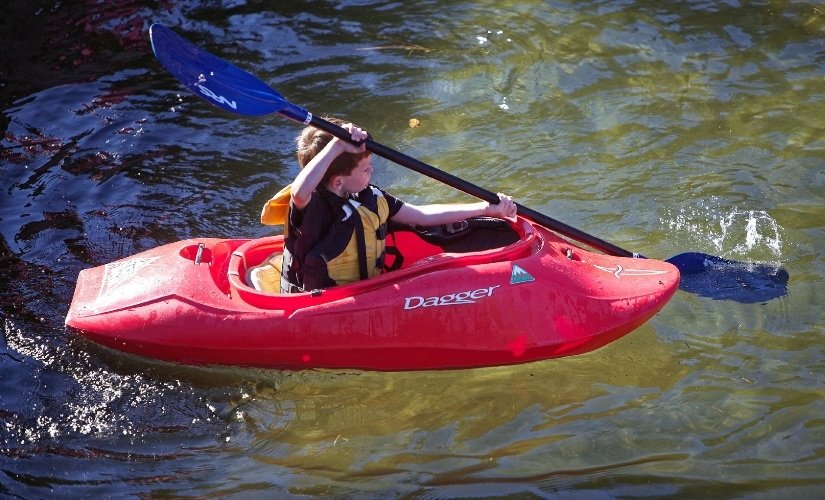
Kayaks for kids come in different sizes and are meant for different age ranges, starting from four years old.
Pros of Kids’ Kayaks
They are short and wide, making them stable and maneuverable. These qualities offer young paddlers a nice, safe platform to learn kayaking at a young age.
The kids’ kayaks are made for their size. It would be difficult for a child to use an adult’s kayak. The youth boats are simple and just right for the little kayakers.
Cons of Kids’ Kayaks
The children will soon outgrow them. Kids grow up so fast. Before you know it, they will not be able to use their small kayaks anymore.
Other Kayak Types
14. Tandem Kayaks
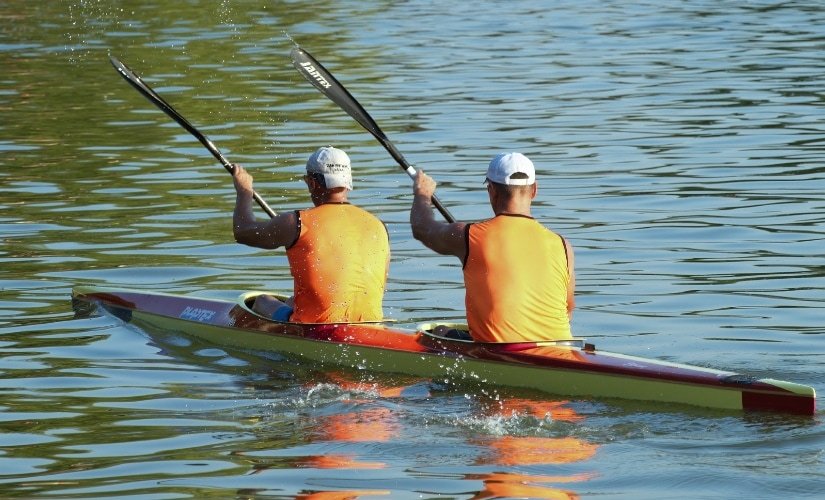
A tandem kayak is designed to be paddled by two people. There are two cockpit areas for each paddler. As you can imagine, these kayaks are long. They can be used to introduce newbies to paddling or to just share the experience with a loved one.
Pros of Tandem Kayaks
You will have a blast kayaking alone. But when you are with someone you love, the experience becomes even more delightful. Whether it is your spouse, child, or friend, this is an awesome way to bond and make lasting memories.
Maybe your friend or kid wants to get into kayaking but they are scared of paddling a kayak on their own. A tandem allows them to get practical lessons without being all alone.
A tandem boat is much longer than your average kayak. Do you know what this means? Extra storage space! In fact, some people buy tandem kayaks for single-use—think anglers, divers, and campers. Since you can paddle a tandem alone, you get to bring all your gear for long or overnight adventures.
Cons of Tandem Kayaks
The two paddlers have to follow a certain rhythm. Before you achieve that, there may be a lot of fighting. It can be frustrating and it requires a lot of patience and understanding from both sides.
Tandem kayaks can be really long. They are bulky, heavy, and stressful to store and transport. You will need a friend to help with the transport part.
15. Pedal Kayaks

A pedal kayak is one that is propelled by pedaling, instead of a paddle. Through this pedal motion, the kayaker operates fins, a propeller, or another system under the kayak, causing it to move forward.
Pros of Pedal Kayaks
Your hands will be free. When paddling a boat, your hands are constantly engaged. This may not be an issue when kayaking leisurely. But you will want your hands to be free when doing something like fishing. Pedal kayaks make this possible.
Another benefit is that these boats are generally faster than paddle-driven kayaks. Leg muscles are much stronger than arm muscles. You can propel the kayak more efficiently than you would while using your arms. So if you want to cover longer distances in a short time, pedal kayaks are the best.
Cons of Pedal Kayaks
They are expensive. You can get a regular paddle-driven kayak at a really low price. But you will have to pay a little more for a pedal kayak of the same size.
With some pedal kayak models, the pedal drive system cannot be used in shallow waters. You may have to retract the pedal system or avoid shallow waters altogether.
16. SUP-Kayak Hybrids
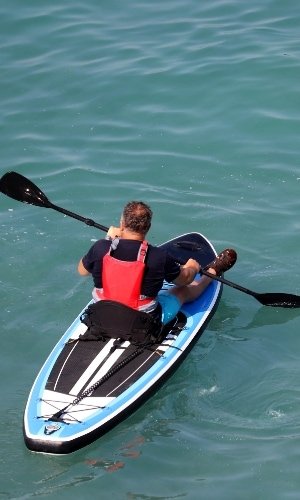
A hybrid is a combination of a kayak and a standup paddleboard. It’s like a paddleboard with a kayak seat. Both kayaking and SUP have their benefits and some people can’t choose one. A SUP-Kayak hybrid lets them enjoy the two sports with a single vessel.
Pros of SUP-Kayak Hybrids
As mentioned, both activities have their benefits. With a hybrid, you don’t have to pick one. For instance, when SUPing and the wind gets too strong, you can shift to kayaking. Or when you have been kayaking and you’d like to stretch your legs, you can easily stand and continue paddling.
SUP-kayak hybrids are not expensive. Some inflatable paddleboards even come with a kayak conversion kit so you can quickly convert it into a hybrid.
Cons of SUP-Kayak Hybrids
This concept is still new. Most hybrids don’t have footwells or a place for your feet to rest. It can be uncomfortable to sit with your legs stretched straight in front of you with nowhere to place them.
Conclusion
As you have seen, kayaks can be used to do almost all kinds of water-related stuff. They are perfect for the adventurous paddler as well as the kayaker who loves to enjoy a serene trip. Most of the boats are designed for a specific purpose like the whitewater and touring kayaks.
Others, like the recreational, fishing, and crossover, are suitable for two or more variations. You only have to choose what will work best for you.
Did you enjoy this article? If you have questions about the types of kayaks, feel free to ask us below.

